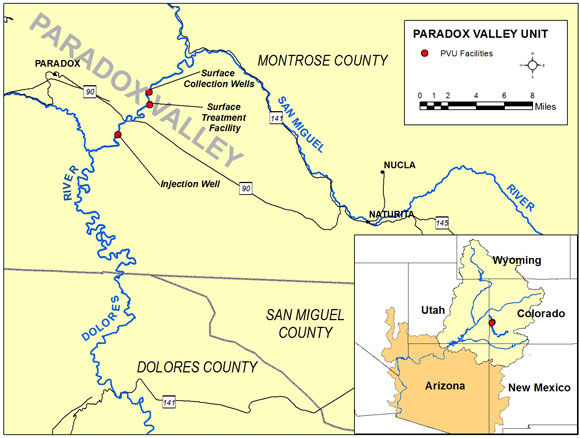Some information may be outdated.
Lovers of the Dolores River are alarmed by one of the four alternatives proposed by the U.S. Bureau of Reclamation to address infrastructure in the Paradox Valley in Colorado.
The Paradox Valley Unit includes an aging salt injection well that extracts naturally-occurring salty brine groundwater from the valley and injects it 15,000 feet underground.
The existing system, which has been operating since 1996, is used to prevent the saline water from reaching the Dolores River, a tributary to the Colorado River.
The Bureau of Reclamation’s Environmental Assessment says the system injected approximately 100,000 tons of salt into the well annually, preventing this salt from degrading the quality of Colorado River water.
However, that infrastructure is reaching its limits. According to a public presentation put together by the Bureau of Reclamation and available online, the well is nearing permitted pressure thresholds, which can threaten sources of drinking water and can have seismic consequences. In March of 2019, an earthquake was linked to the well’s activity.
The agency’s draft plan outlines four possible courses of action, including shuttering the unit and not replacing it, building a new injection well in one of two locations, and two different plans for alternative methods of disposing of salts without potentially contaminating the Colorado River. Some of these proposals have met with opposition from river organizations and landowners in the area.
One of the locations proposed for a new well has hit a nerve with river runners.
“The proposal includes constructing 1.3 miles of new road upstream from the current injection well, crossing back and forth over the Dolores River with two new bridges, accompanied by a new powerline and buried pipeline,” the Dolores River Boating Advocates said in a statement to their supporters. The proposed location they refer to is upstream from the existing well, near the confluence of the Dolores River Canyon and Wild Steer Canyon.
“Needless to say, the impacts to the wild character of the Dolores River would be devastating,” the action alert continues. “The Dolores River is one of the last, best, unspoiled places on the Colorado Plateau.”
Lindsay Trudeau, a Moab resident, recently purchased property close to the existing injection well with the intention of someday building a home there. She said she knew about the Paradox Valley Unit and the pending new infrastructure when she bought the property, but she didn’t know the details of the proposed locations for the new well.
A section of road that is included in one of the potential locations would go through Trudeau’s property.
“None of the options are great,” said Trudeau. “All of the options have huge environmental impacts. And then of course they all have different costs associated with them. So there’s a lot of things to weigh.”
She didn’t object particularly to the possibility of the road crossing her property, but she was dismayed by the proposed bridges and roads that would be built across the Dolores River Canyon over a scenic stretch of river.
“We have such a limited number of truly wild, riparian spaces, and this is the one that would potentially have the biggest impact on that wilderness character,” she said. “Since I’ve lived there, I’ve seen evidence of bears on that stretch of river; there’s bobcats, there’s foxes, there’s beaver, there’s otter, there’s all kinds of animals. And it would turn that area into kind of an industrial zone, with a road and a plant and fences and bridges.”
“When you consider that estimates suggest humans are responsible for more than half of all the salt ending up in the Colorado, it seems that we could take a look at human practices affecting water quality rather than devastating this rare and spectacular place in order to remove naturally occurring salt,” Trudeau said.
In a 2017 study titled “Saline soils and water quality in the Colorado River Basin: Natural and anthropogenic causes” by Dr. Gabriel LaHue at the University of California-Davis, the author estimated that about half of the salt contaminating the Colorado River is from man-made sources. LaHue is now an assistant research professor of soil science at Washington State University.
Citing data from the Bureau of Reclamation, LaHue estimated that about 47% of the total salinity in the Colorado River comes from natural sources, while the remainder comes predominantly from agricultural run-off and other man-made sources.
Removing natural salts like those in the Paradox Valley groundwater may be easier than addressing agricultural pollution because it can be managed at a point source—a single location that accounts for a large proportion of salinity, rather than widely dispersed sources.
“Injecting a bunch of salt into the earth instead of cleaning up our human practices seems like a backwards way of looking at the problem,” said Trudeau.
The Bureau of Reclamation is accepting public comments on the draft Environmental Assessment and the four alternatives until Feb. 4. More information on the project can be found atusbr.gov/uc/progact/paradox. Comments and questions can be submitted by email to paradoxeis@usbr.gov
The Bureau of Reclamation is accepting public comments on the draft Environmental Assessment and the four alternatives until Feb. 4. More information on the project can be found atusbr.gov/uc/progact/paradox. Comments and questions can be submitted by email to paradoxeis@usbr.gov
Appreciate the coverage? Help keep local news alive.
Chip in to support the Moab Sun News.





